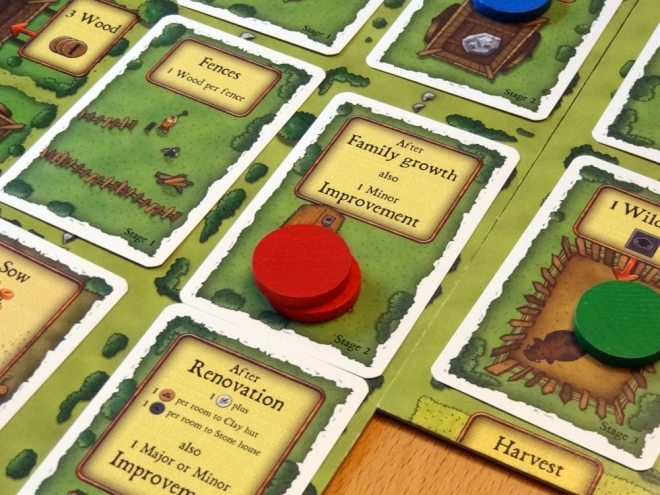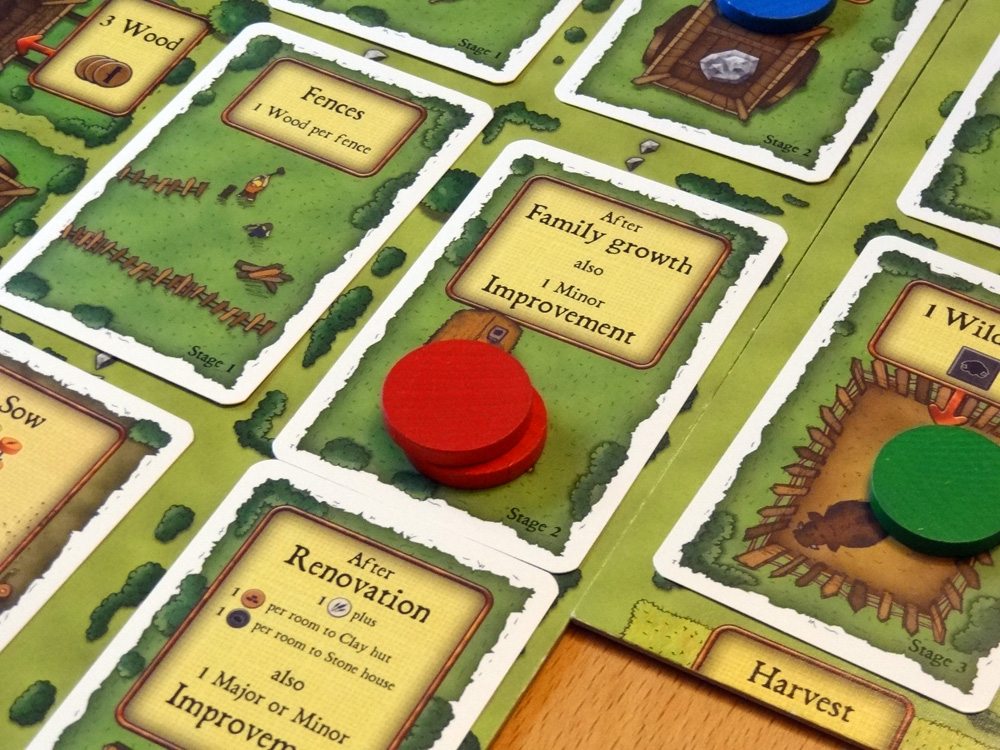
My wife and I just welcomed our third baby last month, and since it’s been several years since the last time, I’m becoming reacquainted with the lifestyle of a new parent. One thing I quickly realized was that I haven’t had as much time lately for playing games—and that the games I do have don’t really seem very relevant to my day-to-day obligations.
Take Agricola, for instance, a wonderful worker-placement game about farming. In Agricola, you start with just two workers (a husband and wife) in a small wooden hut and develop your plot of land by plowing fields, fencing in pastures, and raising crops and livestock. One of the most important strategies in the game is to have more kids: not only are kids worth a lot of points at the end of the game, but you can also send them out to work pretty much as soon as they’re born. Oh, and while the wife is having a baby, she can also build a minor improvement, like an oven.
What’s more, it only takes one of your workers one turn to make a kid (the reference material indicates that this turn represents pregnancy), and then they’re good to go. Of course, you gotta feed them, but then they’re a productive member of the family—I suppose the 3 points represents the fact that they’ll take care of you when you’re old and feeble.
However, having a newborn in the house made me realize that to play Agricola more realistically, you’d have to implement a few changes to the rules:
- Put two people in the Family Growth space instead of one. If you have more workers, already, put them there, too—the kids are too interested in mom’s growing belly to go out and build fences.
- After the baby is born, it can’t work for another 5 turns, at least.
- The father and mother take turns staying up all night (and thus sleeping in the next morning). To simulate sleeping in, set aside one of your workers until all the players have placed all of their other workers. You get to pick from the actions that are left. Oh, and to simulate your lack of sleep, take the wrong resources.
- Most of your family members need to eat 3 food every time Harvest rolls around. The baby doesn’t need to eat as much (only 1 food) but you need to feed it every two hours. So, every time it’s your turn. Make everyone wait on you while you feed the baby. Be sure to burp the baby, too, or it’ll get upset or spit up.
- Corollary to #4: When your child is a teenager, they’ll eat 5 food every turn. You may need to take Begging cards if you don’t have enough food.
- When you send your children out to work, if they’re on a space next to another child, then they’ll spend the time either playing with each other or bickering. Either way, they’re not working. Take only half as many resources as you should have.
Happy farming!
Here are a couple other modified games, inspired by real-life parenting experiences.
Zombie Baby Dice
Summary: your baby is screaming and you’re trying to get it to sleep as quickly as possible so you can get some sleep yourself.
Number of Players: 2
Best for: Parents of newborns
How to Play:
Use a set of Zombie Dice. Pull out 3 dice to rock the baby. Roll them: Brains represent the baby dreaming—set them aside. Blasts represent the baby crying—set those aside as well. Footsteps mean that you need to rock them a little more. You’ll re-roll these if you continue rocking.
If you get 3 blasts, then the baby resumed screaming and your turn is over. Pass the baby to the next parent. If not, you may continue rocking the baby by adding more dice until you have three (including previously-rolled footsteps) and rolling those.
If you decide the baby is sound asleep and want to put it down in its crib, take all the remaining dice in the cup and roll all of them. If any of them come up blasts, the baby woke up again. Otherwise, count the number of brains showing on these dice—that’s how many hours of sleep you get. Pass the baby to the next player.
Game End: Play as many rounds as it takes for both players to collapse from exhaustion. Set a timer for two hours, then get up and start again. Game continues until baby is old enough to sleep through the night (approximately 2-12 years).
Winner: The baby.
You Might Also Like: Guess Why Baby Is Crying?
Pass the Pigs Kids
Summary: Not the classic press-your-luck game, but rather a strategy for when your kids are simply driving you nuts.
Number of Players: At least two parents and any number of kids
Best for: those days when you’re at the end of your rope
How to Play:
Give the kids to your spouse. Go to your happy place for an hour. Hope your spouse manages to keep the kids from touching each other, or your score goes back to zero. Be prepared for when the kids are passed back to you.
Game End: When your kids finally stop bickering at each other, or when they move out, whichever comes first.
Winner: This is a cooperative game for the parents. You both win—or lose—as a team.
You Might Also Like: The classic “Who Can Stay Quiet the Longest?” Game.
Candy Land
Summary: Be the first to reach the candy castle by drawing cards and moving to the corresponding color space.
Number of Players: as few as possible
Best for: teaching kids (and parents) that life is futile and your fate is unavoidable
How to Play:
Shuffle the cards and set each player’s pawn at the start space. On your turn, draw a card and move to the next space that matches that color. Try not to sigh too loudly.
Game End: There is no guarantee this game will actually end.
Winner: The parent who wasn’t home when the kid asked to play.
You Might Also Like: Pulling teeth.
So, geek parents, what games do YOU play?







Candy Land and Chutes and Ladders…UGH. It’s like the game designers were interested in training children for the world of the blue collar workforce. No matter how far up you climb, BAM, back down where you started/where you belong.
You really are spot on with these game assessments!
Games like Chutes and Ladders and Candyland I viewed as educational; they teach the kids how to play a game. Take turns, roll dice / draw card / etc to move, there is a goal. When they they were 6 my girls played games like Fluxx, Star Wars Epic Duels, Callisto
The problem with Chutes & Ladders and Candyland is that they’re ALSO implicitly teaching kids that games are about luck and not skill—but young kids don’t understand that, and they get frustrated when they lose without knowing that there’s really nothing you can do about it. There are alternatives that also teach taking turns, rolling dice, moving around but include actual choice, which I think is absolutely key to board games.